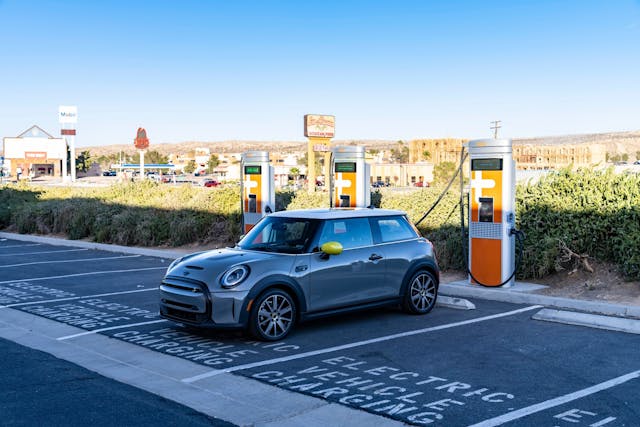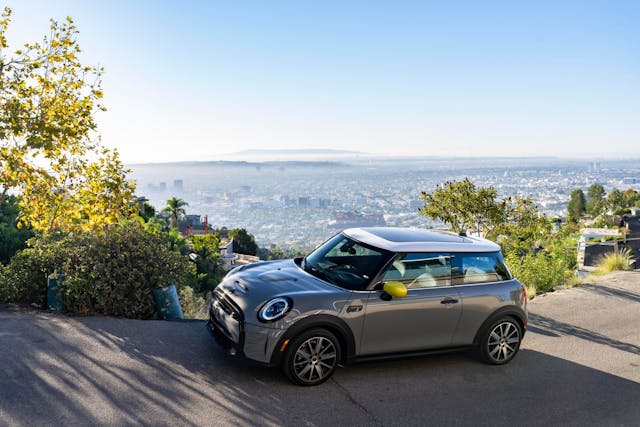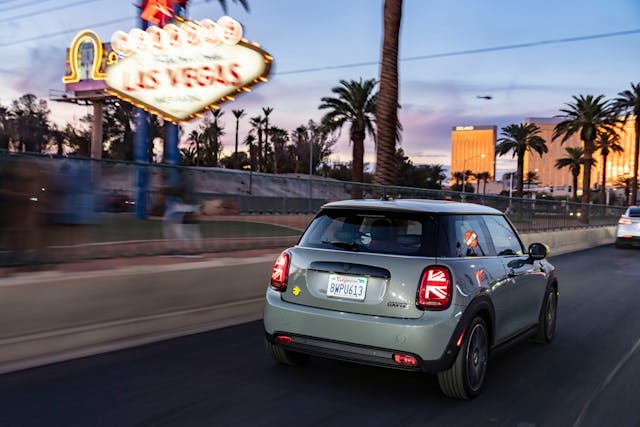2023 Mini Cooper SE Review: Good spark, gentle spice
I know my audience here, so let’s get real: The all-electric 2023 Mini Cooper SE is likely not the car for you. Forget the battery—it’s plainly obvious that even the standard gas-burning Cooper S has evolved into something very different than the plucky R53-generation model that relaunched the Mini brand under BMW ownership in the early 2000s. It’s a fair bit larger, less distinctive, and the once-pure styling has become muddled.
Value isn’t the play either; at a skosh over $33,000, the 2.0-liter turbo-four Cooper S arguably overcharges and underperforms against the current VW GTI ($32,020), Subaru WRX ($30,600), and Honda Civic Si ($29,195). In particular, the WRX and GTI are a significant step above the 189-hp Cooper S in performance and standard equipment. You need to spend $38,650 on a zero-options John Cooper Works model for something with comparable performance and fun. Or, for $255 less, you could have a rear-wheel drive 2023 BMW 228i coupe. Madness, I say!

Back to the SE, Mini’s city-focused EV. “Supply chain issues” nixed the existing $30,750 Cooper SE for 2023, so you won’t ride in this zappiest Mini for anything under $35,075 (not including available tax credits and state-specific EV purchase incentives). For that price, you get:
- 181 hp and 199 lb-ft from a single BMW i3-sourced electric motor between the front wheels
- A 32.6-kWh T-shaped i3 battery pack (of which 28.9 kWh are usable) that returns an EPA-rated 114 miles of range.
Even among other EVs of a similar size (Chevy Bolt, Nissan Leaf), this isn’t the strongest set of figures, but it gets better in terms of charging. Level 2 home and public charging peaks at 7.4 kW with an estimated 20 percent charge added per hour, but a peak of 50 kW on Level 3 DC charging nets up to 80 percent charge in 36 minutes. Not bad.
One imagines that the development of the Cooper SE, using existing i3 bits initially earmarked for use by BMW through 2024, was a relatively inexpensive bit plug-and-play engineering. There’s upside to that approach from a cost and path-t0-market standpoint, but it also means little engineering wiggle room to coax out much more range, performance, and charge speed.
Disclosure: This is the third time I’ve driven the Mini Cooper SE. The first instance was a few moments behind the wheel of a camouflaged pre-production prototype in Germany, back in 2019. That experience involved a few medium-speed maneuvers on skidpads and cone courses. A gaggle of excited Munich engineers swore up and down the Mini enthusiast would find the SE just as compelling and cheeky to drive as the gas-powered S counterpart, even with an extra 331 pounds to lug around and a battery pack and e-motor in place of a burbly little four cylinder and a manual transmission.

My second scoot in the SE was at the global product launch in Miami. Florida’s roads are unerringly arrow-straight, so 50 miles of congested highway driving taught me little about the Cooper SE’s dynamics. It did, however, suggest quite a bit concerning what Mini expects of the car’s customers. Mini rented a large, flowing art gallery in Miami’s Design District and an event space for the product presentation, which featured millennial models futzing with their Cooper SE in equally cool urban spaces.
Mini seems to pitch the SE less as the brand’s first proper foray into high-volt hot-hatchery and more as a chic runabout with fun colors and a low carbon footprint. The cost is not far off from the premium price tag existing Mini owners have swallowed, while the modest range keeps its use case firmly within the confines of urban sprawl. This is a car built for a specific purpose (basic commuting and errands for a handful of passengers) in a specific place (a city, near charging infrastructure) for a specific customer (affluent fashion-forward folks who probably have a second car for long-distance travel).

That was my perception, anyway. Eager to be proven wrong, I recently attended a BMW’s Test Fest press event in Palm Springs, California, a drive-’em-all program that makes much of the BMW/Mini/Rolls-Royce lineup available for driving loops on public roads. My preferred route cut through 15 minutes of stop-and-go desert traffic before spitting me out at the base of the serpentine Palms to Pines scenic byway—a squiggle of switchbacks perfect for small, nimble cars.
Through the surface street traffic, the SE comported itself excellently as a tidy commuter. Power from BMW’s in-house electric motor is direct and instantaneous; aside from occasional intrusion from the nervous traction control system when we went a little too deep in the throttle, thrust feels as smooth as in any modern EV.
Regenerative braking force can be toggled between two distinct modes via a switch on the dash, with the “high” setting as default. In traffic, this function was surprisingly aggressive, which meant that aside from moments in which I needed to rapidly decelerate from cruising speed, I hummed about roads in low-regen mode. The experienced roughly apes the cruising characteristics of a standard gas-powered Cooper with an automatic transmission.

The Cooper SE yoinks much of its hardware from the now-defunct BMW i3, and the Mini shares the same four driving modes, albeit with slightly massaged names—Sport, Mid, Green, and Green Plus. Differences between modes are apparent to the driver by way of varying throttle response and, in the case of Green Plus, the a lack of available air conditioning. Range was not really a concern on this truncated outing, so I bounced between Mid and Sport depending on my ‘tude.
Onward, into the mountains. 199 lb-ft isn’t a heart-fluttering figure these days, but Mini’s 6.9-second 0-60 mph claim feels highly underrated. We’d wager something much closer to six seconds, a figure observed by other independent testers. Even up the steep desert mountain passes, the SE rushes forward with a satisfying, unbroken tug. There’s some drop-off beyond the 65 mph mark, but the same can be said for the gas-sipping Cooper S.

Slower traffic stymied some of the better roads on our route, but I was nonetheless more impressed with the SE this time around than after my two prior drives. Turn-in is quick, body roll is surprisingly minimal, and with so much immediate torque, corner exit is a tire-shrieking, wheel-tugging riot. I only wish there was more verve, more punch, more gumption, especially with the SE’s surprising inclusion of the grippy Goodyear Eagle F1 footwear.
With suspension componentry cribbed from the larger Countryman and Clubman, the SE rides 0.7-inches higher than the Cooper S for better battery clearance. Not exactly a monster truck, and the rise is offset by a center of gravity that Mini claims is 1.2 inches lower than the Cooper S. The chassis better balanced too, with a weight distribution of 54:46 against the Cooper S’ 68:32.
Spirited driving through twisty roads is fun, but not thrilling. Handling is sharp-ish and will likely be described as “zippy” by non-enthusiast owners, but ride isolation and noise over the craggier stuff transmitted a smidge too much noise and shock for what presents itself as a premium machine. Steering is nothing special, which I suppose isn’t all that surprising.

Time stuck at sunbaked stoplights gave me time to drink in the interior details. Despite my earlier moaning and groaning about Mini’s elevated pricing, the cabin feels not so much an overly-outfitted econocar and more like a well done BMW hatchback. Fit, finish, materials, and presentation are all noticeably elevated above cars of a similar size, like the new VW GTI, as is on-road composure.
For our money, we’d wait for the next-generation of Cooper SE, arriving sometime for the 2024 model year. Substantiated reports indicate Mini will deliver a smaller exterior size with a roomier interior, riding on a dedicated EV platform carrying a bigger battery, longer range, and stronger performance. Too small for your daily needs? The all-electric Mini Aceman compact crossover is buzzing just over the horizon, with an arrival also slated for some time in 2024.
Mini has made its name on building spunky, characterful little cars that feel a little special. That personality carries over to the EV experience in the Cooper SE, but a taste of this sizzle cannot make up for what is simply a not-that-compelling steak. It does, however, make us genuinely curious and excited to see what Mini is cooking up for the future.
2023 Mini Cooper SE
Price: $33,900/$36,700 (base/as-tested)
Highs: Gutsy motor, sharp-ish handling, premium interior fixtures.
Lows: Truncated range, stiff ride, no base model pricing for 2023.
Takeaway: If it’s an electric hot hatch you’re after, keep moving. But a stylish and spunky little premium EV? Right on cue, if you need it now.


